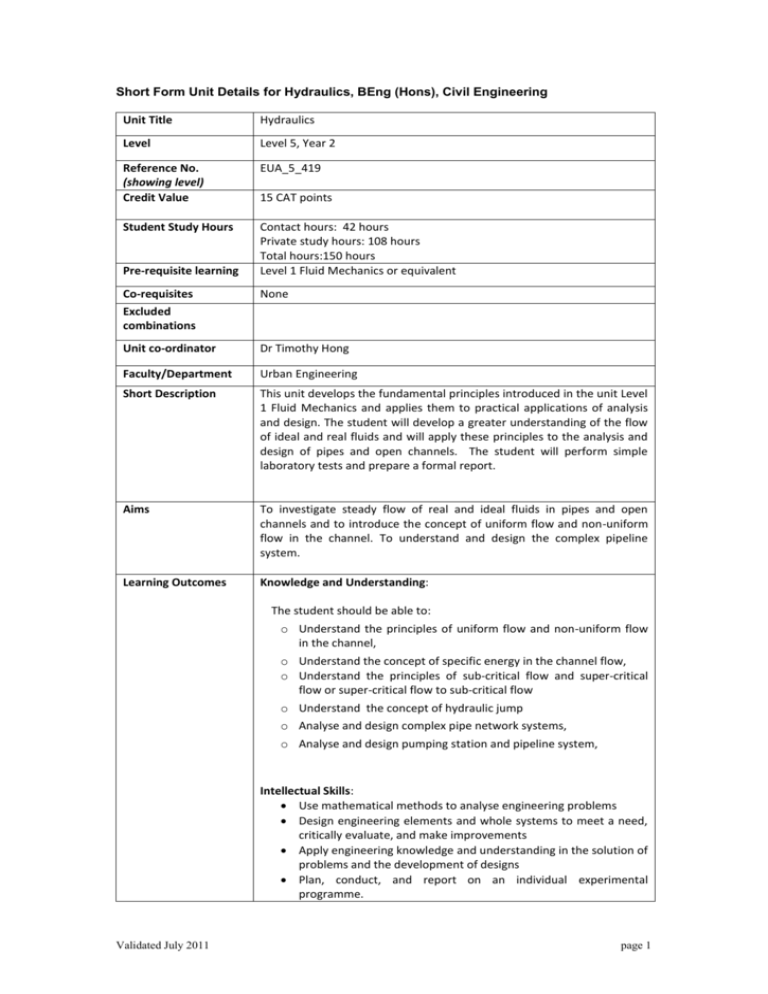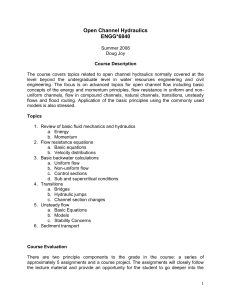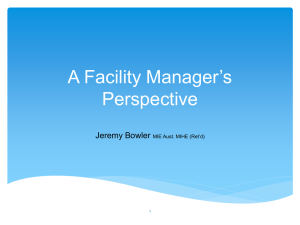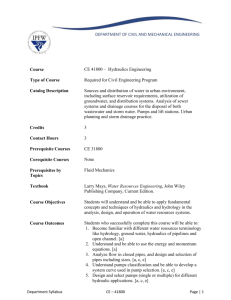Hydraulics
advertisement

Short Form Unit Details for Hydraulics, BEng (Hons), Civil Engineering Unit Title Hydraulics Level Level 5, Year 2 Reference No. (showing level) Credit Value EUA_5_419 Student Study Hours Contact hours: 42 hours Private study hours: 108 hours Total hours:150 hours Level 1 Fluid Mechanics or equivalent Pre-requisite learning 15 CAT points Co-requisites Excluded combinations None Unit co-ordinator Dr Timothy Hong Faculty/Department Urban Engineering Short Description This unit develops the fundamental principles introduced in the unit Level 1 Fluid Mechanics and applies them to practical applications of analysis and design. The student will develop a greater understanding of the flow of ideal and real fluids and will apply these principles to the analysis and design of pipes and open channels. The student will perform simple laboratory tests and prepare a formal report. Aims To investigate steady flow of real and ideal fluids in pipes and open channels and to introduce the concept of uniform flow and non-uniform flow in the channel. To understand and design the complex pipeline system. Learning Outcomes Knowledge and Understanding: The student should be able to: o Understand the principles of uniform flow and non-uniform flow in the channel, o Understand the concept of specific energy in the channel flow, o Understand the principles of sub-critical flow and super-critical flow or super-critical flow to sub-critical flow o Understand the concept of hydraulic jump o Analyse and design complex pipe network systems, o Analyse and design pumping station and pipeline system, Intellectual Skills: Use mathematical methods to analyse engineering problems Design engineering elements and whole systems to meet a need, critically evaluate, and make improvements Apply engineering knowledge and understanding in the solution of problems and the development of designs Plan, conduct, and report on an individual experimental programme. Validated July 2011 page 1 Practical Skills: o Carry out safely a series of planned experiments. o Use laboratory and field work equipment to generate data and analyse reports. o Use computer packages. Transferable Skills: Communicate effectively - oral presentations, report writing, drawing Apply mathematical skills. Work independently Employability This unit will provide the student with a knowledge and understanding of hydraulics at an intermediate level, thereby enabling the student to work to this level in engineering practices. Teaching and learning pattern Lectures and tutorials supplemented by printed or electronic handouts. There will be an emphasis on problem-solving activities to illustrate the principles and concepts developed. This will be used extensively in the lecture programme and will be further supported in regular tutorial sessions. Each student will undertake two laboratory experiments which will be carried out in groups. The timetables for these experiments will be posted on the blackboard site. Indicative content Main Content Uniform flow in the channel Classification of channel flow Channel geometric properties, Channel design formulae, Best hydraulic cross-section Specific energy in the channel flow Non-uniform flow, Understanding of sub-critical flow and supercritical flow, Energy equation for the channel flow, Concept of specific energy Gradually-varied flow Basic differential equation for the gradually-varied flow water surface profile, Classification of flow surface profiles, Water surface profile analysis Control sections in the channel Feeding a pool for sub-critical and super-critical flow, Analysis of flow profile Rapidly-varied flow in the channel Rapidly varied flow by sudden transitions, Super-critical to subcritical flow (hydraulic jump), Mathematical derivation of hydraulic jump Hydraulic structure related to rapidly-varied flow in the channel Sluice gate, Weir, Fumes Validated July 2011 page 2 Ideal Flow Equation of continuity for two-dimensional flow. Circulation and vorticity. Stream function and velocity potential. Curved motion, free, forced, and combined vortices. Basic flow patterns and combinations of flow patterns. Boundary Layer Theory Laminar and turbulent boundary layers on plane surfaces. Displacement thickness and momentum thickness. Drag force. Flow round a cylinder. Separation and wakes. Pipe Flow Basic equation of motion in pipe flow, Resistance in the pipe, Resistance equations. Pipe System analysis Pipe network geometry, Analysis of branched pipe network, Analysis of looped pipe networks , Practical case application of pipe network analysis, Hydraulic Transients and Water Hammer A looped pipe network analysis using a Hardy Cross method Pump and pipeline system Types of pump, Energy and power for pump, Specific speed, Net Positive Suction Head (NPSH), Pumping head, Similarity and pump model, Performance curves for pumps, Pump-system characteristics, Equations for pump and pipeline Assessment Elements & weightings The unit is assessed by a combination of examination and coursework with the proportion of marks allocated to each component given below: 70%: 3-hour end of unit written examination in which students are required to answer all questions. 30%: An individual report describing the outcome of a number of experiments carried out in small groups. Regular coursework examples Indicative Sources (Reading lists) Books related to Hydraulics are available in the Perry library. Core materials are: o Chadwick, A., Morfett, J. and Borthwick, M, Hydraulics in Civil and Environmental Engineering, 4th edition, E & FN Spon, 2004. o Douglas, J. F., Gasiorek, J. M., Swaffield, J. A., and Jack, L. B., Fluid Mechanics, 5th edition, Pearson, 2007. o Kay, M., Practical Hydraulics, 2nd edition, Taylor & Francis, 2008. o Featherstone, R. E., and Nalluri, C., Civil Engineering Hydraulics, 4 th edition, Blackwell, 2001. o Hamill, L., Understanding Hydraulics, Palgrave, 2nd edition, 2001. o Twort A C et al. (Eds), Water Supply, 5th Ed, Arnold, 2000 Validated July 2011 page 3 Validated July 2011 page 4







